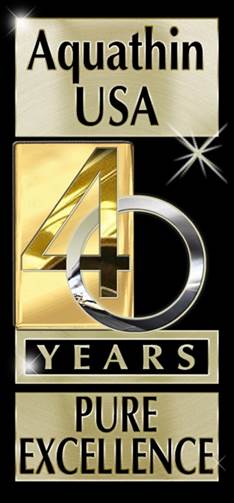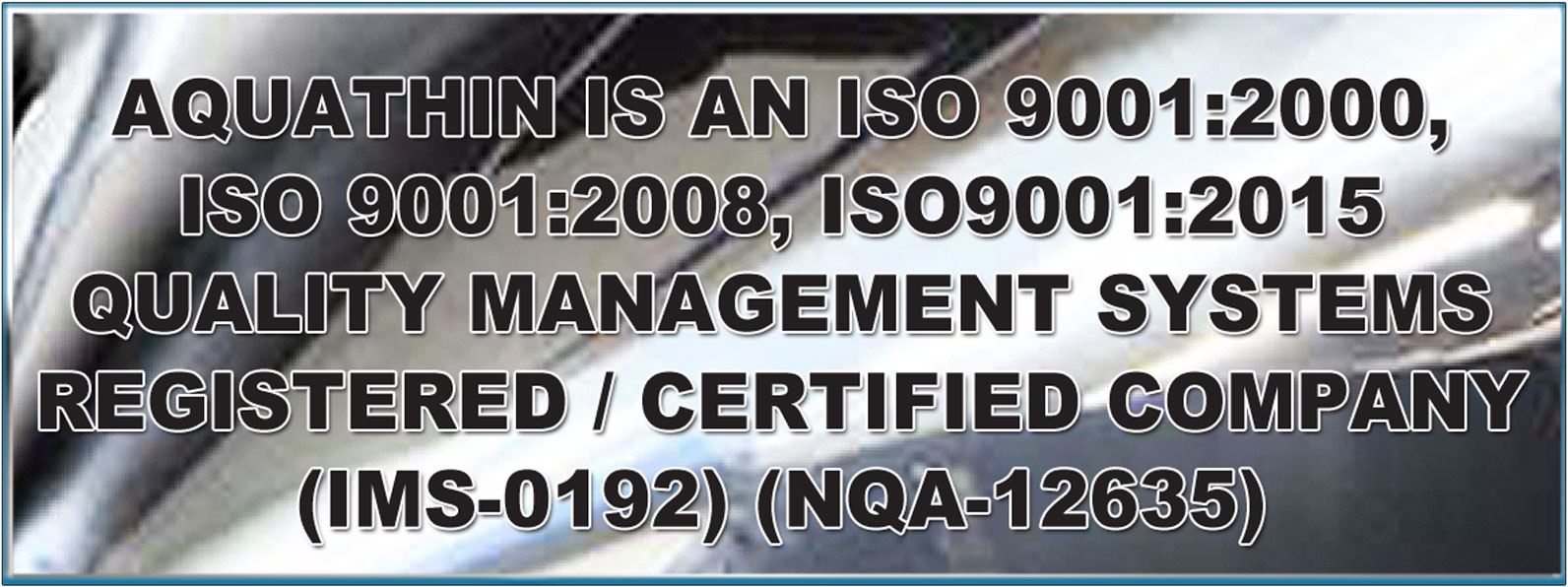How safe is airline water? Bring your own bottle!
"Aquahtin OP-ED Commentary"
The quick read article below is important industry information to share with prospective clients, especially those that travel. You will read about the bacterial and viral contamination of the "potable" water tanks on airplanes. As one who travels extensively, I will tell you this article as thorough as it is, is still lacking. For example, when on long hauls, we are given shaving kits. Shaving or trying to freshen oneself with cool water has the potential for waterborne "bugs" to enter shaving cuts and eyes. Also, that fresh pot of coffee or hot tea is rarely made from bottled water. A nice touch is to advise your clients to make use of the half gallon Aquathin bottle when traveling ! I take two !!
Aquathin has visited this issue with several of the large airlines hubbed in Miami. However, budgetary concerns i.e. unions, fuel costs, etc. took precedence in their priorities. Interestingly however, we have installed in other locations, our commercial RO systems for cleaning engine parts, planes and helicopters where "spot free" rinsing is required.
Lastly, it was really great to see how many of you already read this article and forwarded the link to us. Many thanks....well done on staying informed !
How safe is airline water? Bring your own bottle!
By Nancy Keates and Jane Costello
THE WALL STREET JOURNAL
When Juanita Green needed to take some medication on a flight to Los Angeles, she washed down the pill with a cup of water from the plane’s bathroom sink. It tasted funny, but she tried not to think about it. “For peace of mind,” says the nurse from Miraloma, Calif. “I just hope it’s clean and sterilized.”
FOR YEARS, FLIERS have worried about everything from stuffy cabin air to bad meals. But what about the water? While airlines insist it’s safe to drink, some little-noticed studies from Japan to the Netherlands have turned up some unfriendly bacteria in the tank water, including E. coli and the germ that causes Legionnaire’s disease. U.S. researchers have tested it, too, with mixed results that suggest you don’t know what you’re drinking. The results of our water-quality snapshot: a long list of microscopic life you don’t want to drink, from Salmonella and Staphylococcus to tiny insect eggs. But we do — because we tested it. We packed sample vials and took to the skies, hopping on 14 different flights everywhere from Atlanta to Sydney, Australia. On each, we collected water from the galley and lavatory taps, sealed them up and sent them to a lab for analysis. Worse, contamination was the rule, not the exception:
Almost all of the bacteria levels were tens, sometimes hundreds, of times above U.S. government limits. “This water is not potable by any means,” says Donald Hendrickson, the director of Hoosier Microbiology Laboratories in Muncie, Ind., which tested our samples.
The good news, of course, is that this water isn’t the main drinking supply for passengers, who usually get bottled H2O from the beverage carts. But plenty of people depend on the plane’s taps to wash their hands and brush their teeth. And while the airlines say they rarely serve tap water, many flight attendants say it isn’t that uncommon: When the bottled water runs out, they turn to the tanks — which, under federal regulations, are supposed to provide drinkable water. “It’s the way our service works,” says Sara Dela Cruz, a spokeswoman for the union of United Airlines attendants. For their part, the airlines say they closely follow federal guidelines for drinking water, and say no passengers have ever complained about getting sick from it. “It’s absolutely drinkable,” says a United spokesman. They called our water tests unscientific, and said our own samplers could have contaminated the results. “Someone with dirty hands must have used that sink,” said a spokesman from National Airlines, where the lavatory sample came back positive for coliform. But our experts said human contamination wouldn’t explain all our results. Some of the water we collected on a short flight to St. Louis, for example, contained Pasteurella pneumotropica, a bacterium primarily carried by rodents. Similarly, our Chicago-to-Los Angeles trip turned up Pseudomonas, a highly resistant bacterium associated with a range of infections. And while the U.S. government sets a maximum bacterial level of 500 “colony-forming units” per milliliter for municipal drinking water, our lab counted more than four million per milliliter in a single sample alone. That’s roughly the same bacterial concentration you find in a tainted raw hamburger, Dr. Hendrickson says. "If I were the airline, I would worry about what these results say about the sanitation in their galleys."
American Society for Microbiology “If I were the airline, I would worry about what these results say about the sanitation in their galleys,” says Abigail Salyers, outgoing president of the Amirican Society for Microbiology and a professor at the University of Illinois at Urbana-Champaign. This isn’t the first time, of course, that airline cabins have raised a health issue. Travelers have worried about everything from the quality of recirculated air to the potentially fatal blood clots associated with “economy-class syndrome.” But airlines’ tank water may fly beneath the radar, health experts say, because travelers wouldn’t think of linking it to any bugs they might pick up. “People blame it on where they’ve been,” says Arthur Forni, an infectious-diseases physician at Westchester Medical Group in New York. Bacteria counts and lab analysis from The Wall Street Journal's 14-flight survey.
WHEN BOTTLES RUN OUT
Still, at least some people try to avoid it — including a number of flight attendants. “It doesn’t taste good,” says Jennifer Walker, the health coordinator for the union that represents American Airlines’ flight attendants. She says some attendants bring their own bottles to avoid the stuff from the tanks — especially when it’s the only thing left. Indeed, the flight-attendant unions at American, Northwest, US Airways and United confirm that they serve tap when water bottles run out, primarily on full flights. “It happens fairly frequently,” Ms. Walker says.
Do they tell fliers? Only if they ask. “It’s not like we have some huge sign saying ‘This is Tap Water,’ ” she says. In response, American says serving tap water would violate company policy. (Other carriers said the same thing, although several had earlier acknowledged that tap water could get served.) “When bottled water runs out, we offer canned distilled water,” says a Continental spokesman. Our own suspicions about the water came from an unlikely quarter: Zach Bjornson-Hooper, a homeschooled 13-year-old from Alamo, Calif., who became curious about airline tap water when he saw a flight attendant pouring it for passengers. “My parents own a sailboat,” he says, “and I know we don’t drink the tank water on that.” So as part of a science project, he took samples during a trip to Australia and New Zealand — and watched later as colonies grew on his petri dishes. “I got fairly grossed out,” he says. In our tests, we thought the length of the flight, or the country in which it originated, might affect the results. It didn’t. While our lab turned up 750 colonies per milliliter during a Chicago-Mexico City flight, we found millions of colonies on that short hop to St. Louis. Among our other findings: Salmonella, a well-known bacterium that can cause violent illness, on a Continental flight to Newark, N.J. Then there were the eggs: On a United flight, our lab found aquatic insect eggs that, after a few days, hatched into maggots. “I’ve never seen it in all the 26 years I have been testing water,” Dr. Hendrickson says.
To be sure, much of the bacteria we found aren’t harmful — one that showed up in many samples is commonly found in soil. Even the most unfriendly bacteria don’t necessarily cause illness either. And foolproof testing isn’t possible: As airlines pointed out, our samples weren’t taken under sterilized conditions onboard. “It’s unscientific,” said a spokesman for Continental, who said the Salmonella could have come from a customer’s hands. The Air Transport Association, which represents the industry, says our methods were “not consistent with scientific protocols.”
But the microbiologists we talked to said the results are valid — we followed guidelines recommended by our lab and recognized by the Environmental Protection Agency. What’s more, other studies have turned up similar results. In 1999, the Japanese government found excessive bacteria levels in one-third of 65 planes it tested at Narita Airport outside Tokyo. The following year, KLM Royal Dutch Airlines found traces of the bacteria that causes Legionnaire’s disease in one jet. And last January, E. coli was found on the aircraft used by Canadian Prime Minister Jean Chretien. (The Canadian Department of National Defense says no one became sick.)
‘NOT A PRIORITY’ So who’s regulating this? The U.S. Food and Drug Administration is responsible for the quality of airports’ water facilities, like hoses and hydrants. The Federal Aviation Administration is also involved, requiring airlines to clean and flush their onboard tanks (the schedule can vary, but is usually done every 12 to 14 months, the FAA says). And once the water’s onboard, it falls under the regulation of the EPA, which requires airlines to clean tanks quarterly and confirm their water complies with federal standards. But the agencies say they leave most of the monitoring to the airlines. The EPA says spot-checks are rare because airplane water is “not a priority” compared to all the other water systems the agency tracks, says Bill Diamond, the director of the agency’s Drinking Water Protection division. The FDA, meanwhile, says it’s never found problems with the water in airline tanks, and holds inspections only when complaints come up. Still, the FDA has issued six warning letters since 1997 that might disturb some fliers: It found a “dead mosquito-type insect” in an AirTran Airways potable water cart, and cited Northwest for not maintaining “clean and sanitary potable water stations” at its storage system in Detroit. It also warned American Eagle, American’s commuter branch, for not having a splash-back valve on a hydrant that supplied drinking and chemically treated lavatory water. (Airlines say all of the violations have been resolved.) Still, travelers may have something to look forward to. Based on public concerns raised in recent years, the FDA says it’s now starting a program to take regular samples of airline water. And at least one carrier concedes airlines should be doing more: After its own voluntary spot checks, KLM suggested carriers world-wide were vulnerable to similar contamination and advocated creating official water quality test programs. That’s good news for veteran fliers who worry about the water from time to time. But Andrew Baldauf, a 35-year-old attorney from Madison, N.J., isn’t taking any chances. He packs a backpack full of bottled water on every flight. “I don’t want to run the risk,” he says.
FOR THE BEST TASTE IN LIFE
Think Aquathin...AquathinK!!
Edited from Tech Bank 11/4/02


